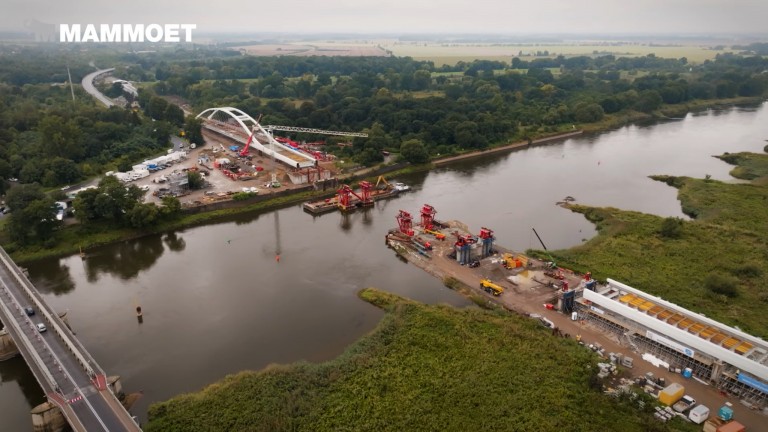The Oder Bridge was built more than 100 years ago along the German-Polish border. It connects Western and Eastern Europe and acts as a symbol of Europe coming together.
As bridges get used for heavy transportation they need replacement. For a railway bridge as historic as the Oder Bridge, a special replacement was designed which was carried out with minimal disruption to the rail network.
The new Oder Bridge includes a network arch bridge with carbon hangers. The 2,100-tonne, 180-metre bridge will help to increase line capacity and shorten travel times by allowing a maximum speed of 120km/h.
Mammoet has a lot of experience when it comes to large-scale bridge projects and operating the specialist equipment needed to move these bridges as complete structures. This allows parallel work in the preparation phase and saves time.
The bridge was assembled on the German side of the Oder and then moved, by Mammoet, as a whole structure across the river to its final installation position.
“Most bridges are floated into place using a combination of Mammoet self-propelled modular transporters (SPMTs), launching plates, and a pontoon,” said Koen Brouwers, project manager at Mammoet. “However, the use of a pontoon here was not possible due to the shallow and changing water levels of the river. Using a large crane, capable of positioning loads with a long reach, was also not feasible due to the weight and length of the bridge.”
Mammoet’s engineers therefore came up with a solution that avoided the use of both crane and pontoon. This solution allowed work to happen regardless of the water level and made the operation more flexible.
Mammoet’s installation process
After first jacking the bridge to two metres and positioning the SPMTs underneath, it was transported to the edge of the river where it was positioned over the first of five temporary supports. The bridge was then launched using a combination of specially designed launching plates and strand jacks that pulled the structure horizontally until it reached the next temporary support.
This process continued until the bridge reached the opposite side of the river. The SPMTs on the rear of the bridge were then removed and skid shoes were installed to slide the bridge into its final position.
At this point, the bridge was taken over by climbing jacks, which allowed the temporary supports to be removed and the bridge to be lowered down to its final resting height.
Around 45 truckloads of specialist heavy equipment were mobilized for this project, including 96 axle lines of SPMTs, 26 launching plates, 10 climbing jacks, and 2 strand jacks.
Plate spinning
One of the key considerations for any bridge launch is the risk of deformation of its structure during the launch process. This posed a big challenge for the engineering team during the Oder Bridge project.
To solve this, temporary supports with hydraulic cylinders were used at the quay edges and in the water, as well as modified launching plates.
“It’s a big bridge and wind loads had to be considered,” said Jack van der Vloet, lead engineer at Mammoet. “It has a large deflection, so the launching plates had to be modified. Typically, they swivel in two directions; however, in this case, they had to swivel 360 degrees. This always gave us full control of the operation.”
The entire skidding equipment had to be customized to execute the operation technically. This meant that all launching plates were retrofitted with a spherical bearing so that they could be moved in all directions. During the launch, the weight on each tower and cylinder was controlled to ensure a smooth and safe operation.
Due to the bridge’s size, all the available launching plates that Mammoet Europe had in stock had to be used.
Infrastructure projects are crucial to support growing populations and economies, and as cities get busier these projects become more challenging.
Mammoet’s experience in large-scale bridge projects, and technical capabilities to move bridges as a complete structure, allows parallel work in the preparation phase and time and disruption savings.
Compared to other bridge projects where cranes or pontoons are used, Mammoet used a different method with modified launching plates. This smart solution can now be adapted for other bridge projects when using a crane or pontoon is not possible or is inefficient.
Read the full article here











